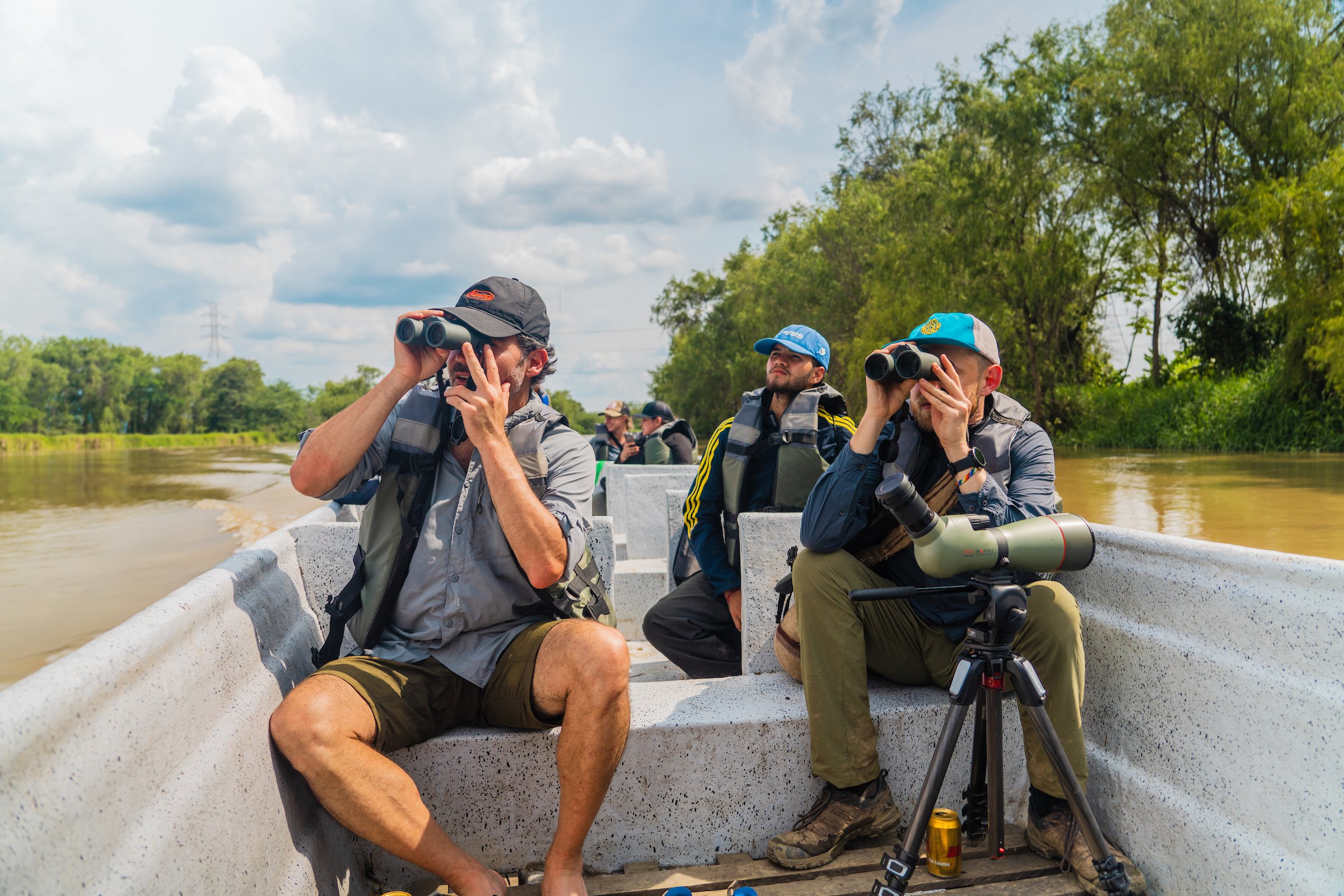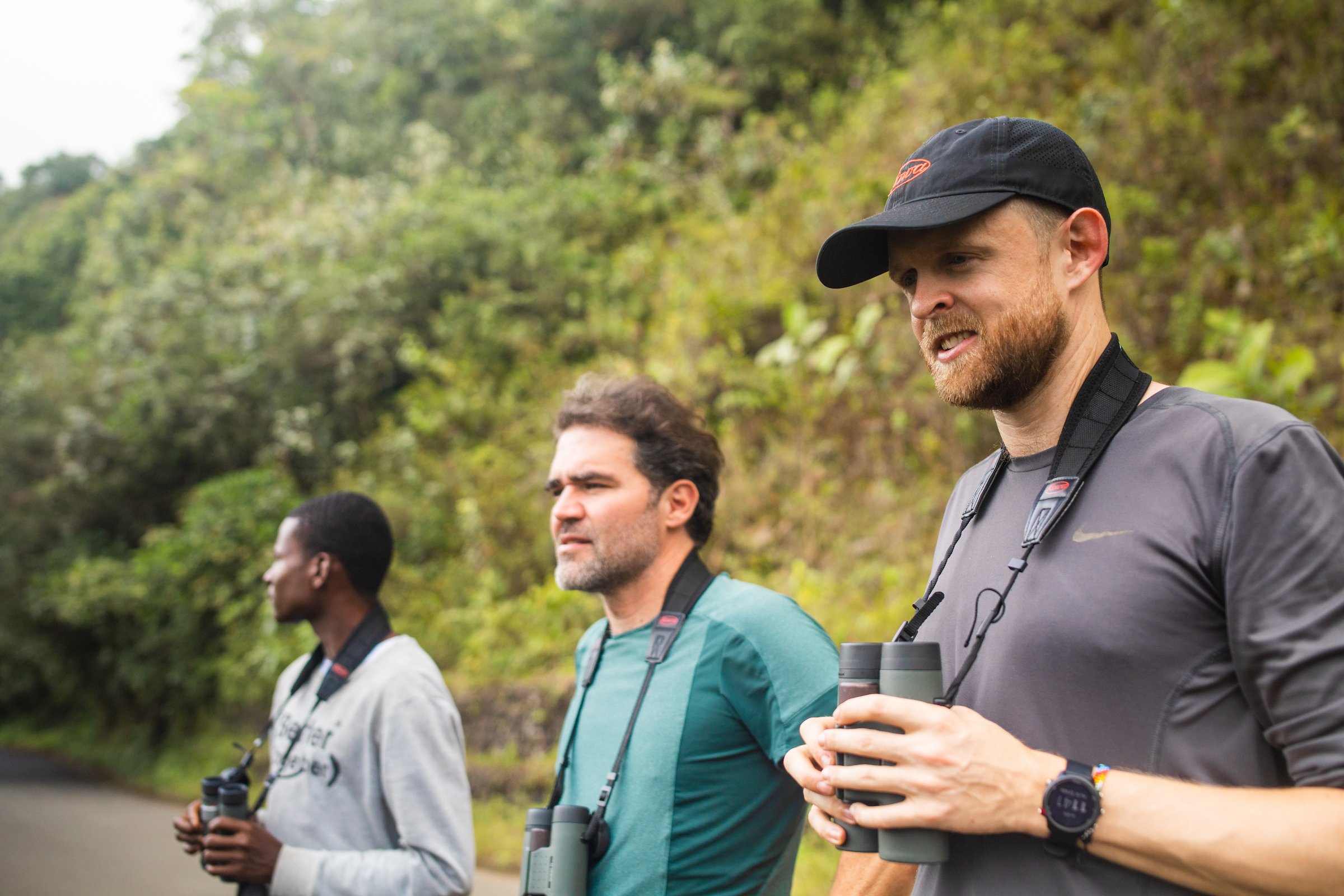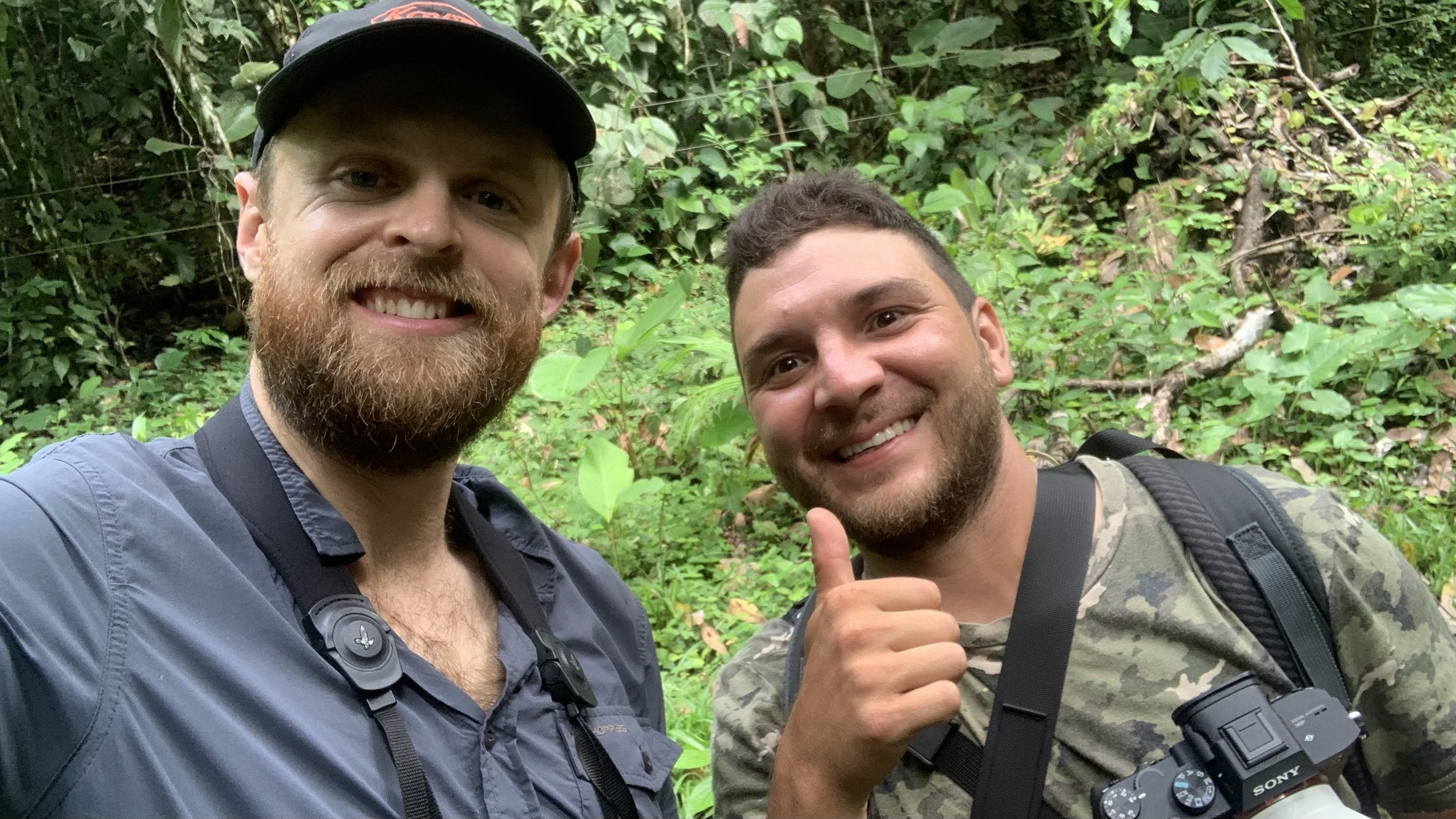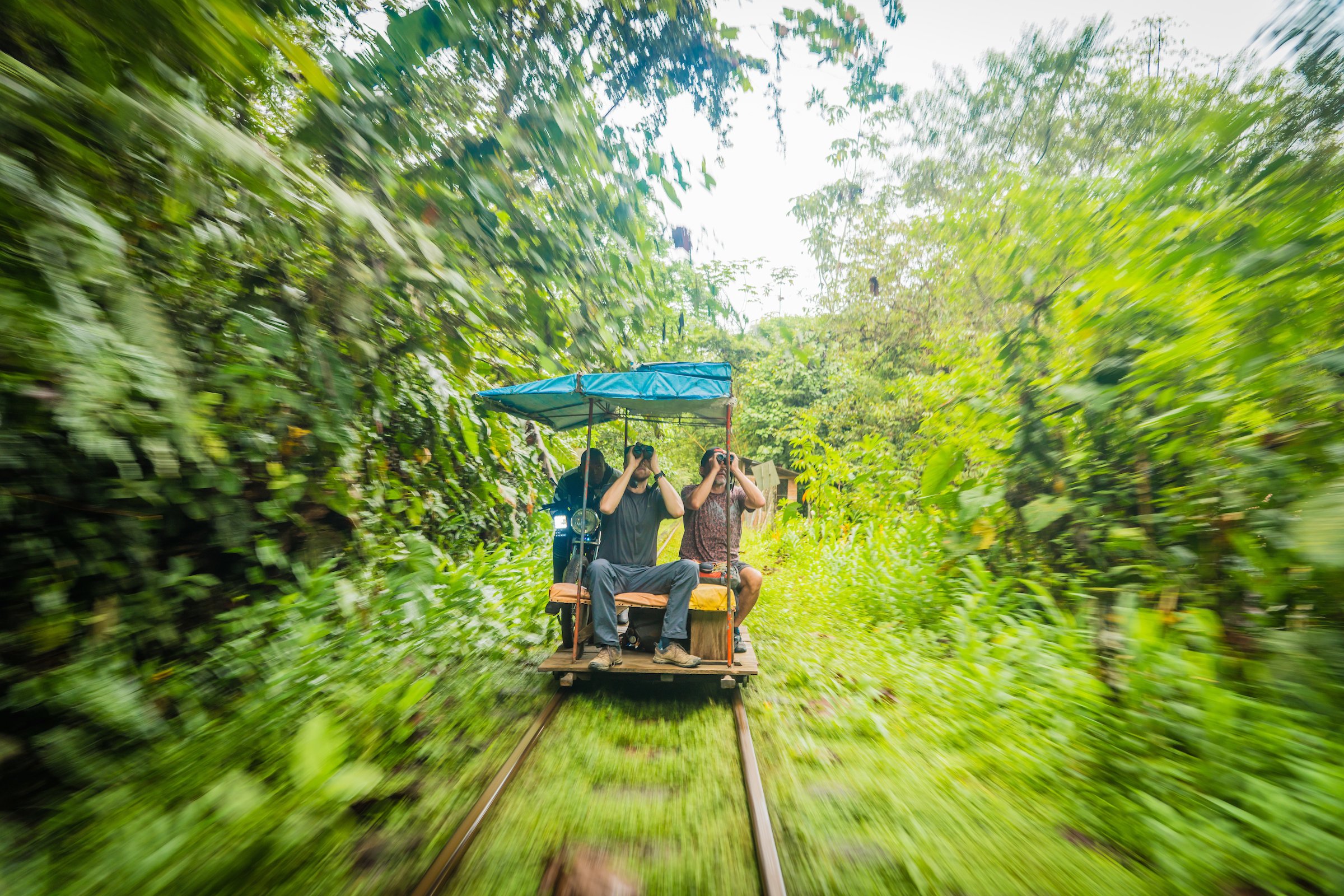Birding in Colombia: Black-and-chestnut Eagle
Join The Birders Show host, Chris on an Andean birding adventure to the nest of the endangered Black-and-chestnut Eagle, one of the rarest birds of prey in the Americas.
I'm sitting in the forest halfway up a sheer Andean mountainside, surrounded by a stinging cloud of mosquitos, when an eerie cry rips through the calm morning air. A second call, longer and thinner, answers back from the dense cloud forest, and suddenly the shadow of an immense black bird passes overhead before alighting on a thick branch and fixing me with a piercing stare.
The huge eagle calls twice more, answered each time by the loud wail somewhere in the canopy up above. Then, the giant bird flies to the nest in one leap, where a tiny chick cheeps with excitement. Before I know it, the female eagle glides down from the hidden treetops and joins the male on the nest. Just for a moment, the pair stand side-by-side before the male glides away. The female lingers for a moment longer, checking on the chick, before soaring away in the opposite direction.
I sit there in silence, heart racing. The eagles I've just seen are a pair of one of the rarest and least-understood birds of prey in the Americas: the Black-and-chestnut Eagle. There are thought to be fewer than 1,000 mature individuals left, and despite their huge size, they are rarely seen, such is the isolated and inaccessible nature of their preferred habitat. Even when these majestic eagles are encountered, they are far more often spotted soaring high overhead. So to observe two adults perched together, fussing over a tiny little chick is a rare and unique privilege. I can hardly believe my luck.
The eagles were extremely vocal, calling back and forth to each other all morning
Rewind a few hours, and I'm walking along a dirt road with Luis Felipe Quintero or Pipe. He's dedicated many years to observing and studying Black-and-chestnut Eagles and discovered the nest I'm hiking to seven years ago. He tells me that he's had a particular affinity for this species since seeing a dead juvenile eagle in primary school; sadly, Black-and-chestnut Eagles sometimes hunt chickens from nearby farms, frequently putting them into conflict with humans. However, that tragically killed young eagle sparked a lifelong interest that led him to a fascination with these rare birds.
Birding Fact: a Black-and-chestnut Eagle dietary study conducted in Colombia found that chickens made up just 14.7% of the bird’s diet, as opposed to wild Andean Guans, which made up over 50%. Interestingly, the study showed that the eagles took roughly the same number of mountain coatis as chickens, and coatis are known to predate poultry chicks and eggs.
He spotted a pair of eagles circling a mountain ridge near his rural home one day. He kept seeing them and realized that they must have been nesting nearby. After a long hike up a steep mountain face, he came to the area where he thought the nest would be. He had to bushwhack through dense cloud forest until he eventually found a large cecropia tree supporting a massive platform of sticks and, more importantly, a juvenile eagle. He's been protecting and monitoring the nest ever since. The eagles have returned annually for seven years and have successfully raised a chick on all but one occasion. For such an endangered species, it's a real success story.
I'd been hoping to visit the nest with Pipe for a few years, so when I found out that the eagles had recently hatched a chick, I hastily made travel plans. When the baby is very small, the parents don't stray far from the nest and visit regularly, so my best chance to enjoy close-up sightings of the eagles was to visit soon. By Pipe's calculations, the chick would be about two-weeks old on the day of my visit.
The male eagle visiting the nest
For obvious reasons, the nest's exact location is kept under wraps, and Pipe is quite selective about who he takes to visit: this isn't a tour you find advertised in local hostels or online. It's also not for everyone: the hike up to the viewing point isn't far in terms of distance but is an extremely steep climb up a muddy, slippery trail. It seems that the price for seeing a Black-and-chestnut Eagle is sweat, sore legs, and a lot of bug bites.
We make good time on the walk, stopping along the way to enjoy lovely views of Golden-headed Quetzal, Chestnut-breasted Chlorophonia, and my lifer Golden-jumped Euphonia. Thankfully, it's a cool, overcast morning, and the steep hike isn't too intense. A day before, the sun was beating down with a ferocious intensity; the walk would have been very unpleasant in that heat.
Celebrating my Golden-jumped Euphonia lifer with Pipe: species 1,348 species observed in Colombia!
Birding Fact: the Black-and-chestnut Eagle (Spizaetus isidori) is typically the top avian predator in most of its range, since it generally occurs at different altitudes to other large neotropic forest eagles. One exception is the Solitary Eagle (Buteogallus solitarius), but since this similarly sized raptor is thought to mostly hunt snakes, it seems that the two species are able to co-exist without aggression.
After a couple of hours of hiking, we crest a ridge and reach an open cow pasture. At that precise moment, mist begins to swirl up through the steep valley, blanketing the open ridge. Visibility drops to almost nothing, and I start to worry that after all this effort, I'll barely be able to see the nest.
Thankfully, though, Andean weather changes at the drop of a hat, and by the time we wind our way down the hair-raising forest trail towards the nesting tree, the sky is clear. I sit down on a dirt step Pipe has carved into the slope while he heads back up the trail to direct my fellow birder and photographer, Amir, to the clearing. I set up my scope and settle in to wait for the eagles to return. I can see the chick - named Isis by Pipe - stirring in the nest, opening its tiny little wings, and blinking in the sun.
The little chick, christened Isis by local guide Pipe, sitting in its nest.
At that point, the eagles start to call and fly down to the nest. Over the next two hours, Amir, Pipe, and I sit silently watching the tree. The eagles visit several more times, giving us genuinely mind-blowing views. The male is more relaxed and lingers for long periods in the cecropia, giving us time to take photos and videos and admire his handsome plumage and fearsome claws in the scope. The female mostly calls overhead but occasionally drops down into the tree for a brief visit.
Our time with the eagles is over in what feels like a heartbeat. We pack up our gear to prepare for the long trudge down the mountain and back to town. I take one last look at Isis, so vulnerable and tiny on her little platform, and walk back up the trail. One last wail sounds from the forest, and I know that her mother is somewhere up there, always watching, protecting her chick. It's a comforting thought to leave with and puts a spring in my step for the long hike home.
The male Black-and-chestnut Eagle watching over its nest
I've had many memorable birding experiences in Colombia, but this intimate encounter with the Black-and-chestnut Eagle ranks among the very best. It's always a privilege to observe a bird's nest, especially such a rare species. The Black-and-chestnut Eagle faces an uncertain and challenging future, as deforestation threatens their habitat and pushes them into more and more fatal encounters with humans. Isis carries a lot of hope on her tiny shoulders, but she's in good hands - and claws - with Pipe and her parents looking out for her. Who knows, maybe one day I'll see her again, her jet black adult feathers gleaming in the Andean sun as she soars over her misty mountain home.

















